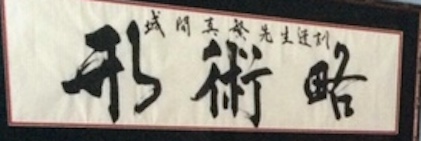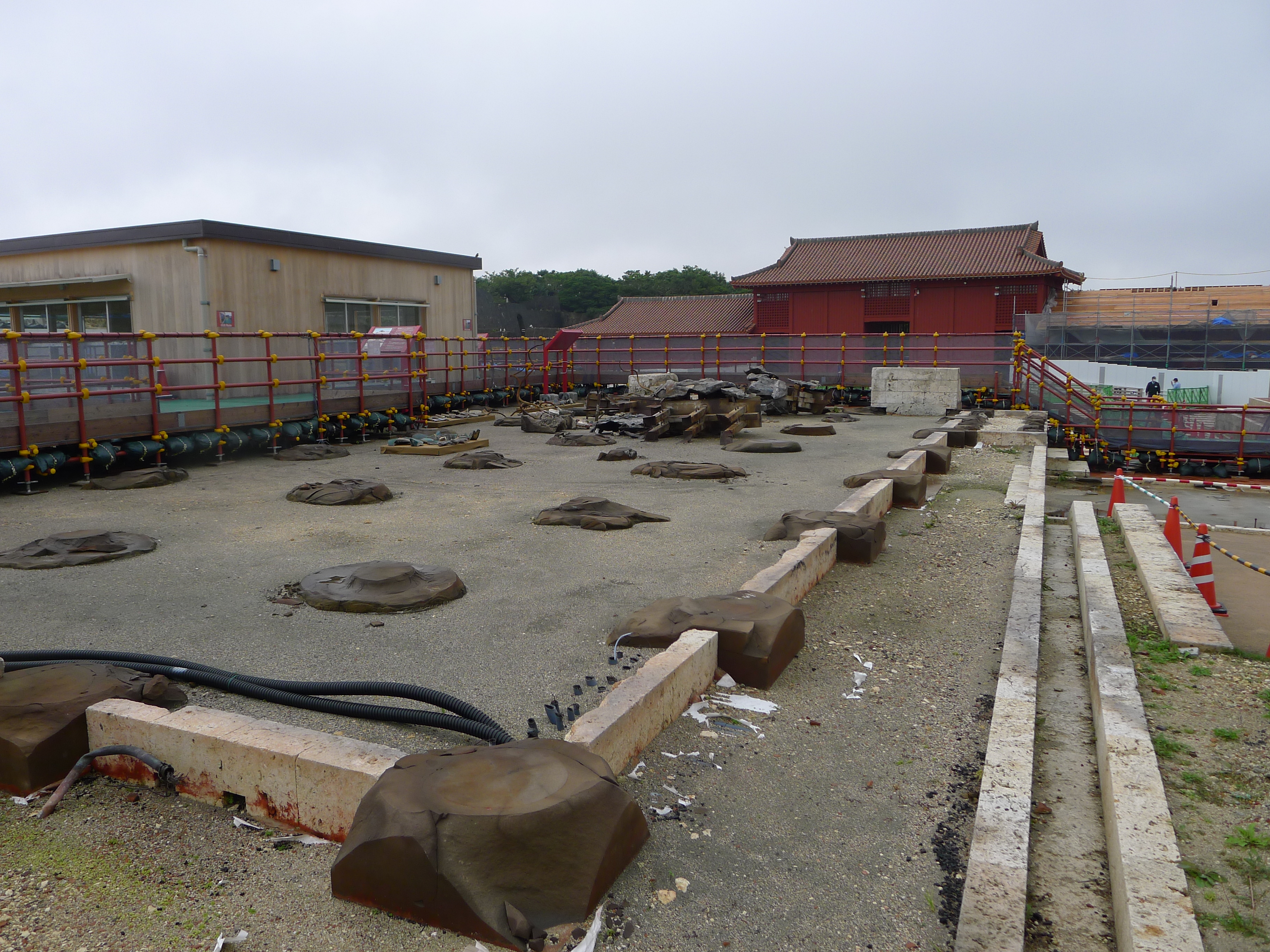|
Shinpan Gusukuma
, read as Shinpan Shiroma in standard Japanese, was an Okinawan martial artist who studied Shōrin-ryū karate as a student of Ankō Itosu. Gusukuma also trained under Higaonna Kanryō in the Naha-te style. Gusukuma went on to establish Shitō-ryū with Kenwa Mabuni. Early years Gusukuma Shinpan born in 1890 in the town of Taira in Shuri, Okinawa. At the age of thirteen, he began the study of karate with Anko Itosu, and in 1908 he began training with Kanryo Higaonna, along with Kenwa Mabuni. In 1909 at the age of eighteen, Shipan was inducted into the Japanese Navy. He became a school teacher by profession and worked as a professor in the Shuri Dai Ichi Elementary School where he also taught karate. He was also known for his skills as an acupuncturist and taught the art. Shinpan began teaching Shorin-ryu shortly after World War II and was associated with Miyagi Chojun, Kyoda Jyuhatsu and Kyan Chotoku. He taught regularly at Shuri Castle and had a dojo at his home in Nish ... [...More Info...] [...Related Items...] OR: [Wikipedia] [Google] [Baidu] |
Shuri, Okinawa
''Sui'' or ''Shui'', Northern Ryukyuan languages, Northern Ryukyuan: ''Shiyori'' is a district of the city of Naha, Okinawa. It was formerly a separate city in and of itself, and the royal capital of the Ryūkyū Kingdom. A number of famous historical sites are located in Shuri, including Shuri Castle, the Shureimon gate, Sunuhyan-utaki (a sacred space of the native Ryukyuan religion), and royal mausoleum Tamaudun, all of which are designated World Heritage Sites by UNESCO. Originally established as a castle town surrounding the royal palace, Shuri ceased to be the capital when the kingdom was abolished and incorporated into Japan as Okinawa prefecture. In 1896, Shuri was made a of the new prefectural capital, Naha, though it was made a separate city again in 1921. In 1954, it was merged again into Naha. History Medieval and early modern periods Shuri Castle was first built during the reign of Shunbajunki (r. 1237–1248), who ruled from nearby Urasoe Castle.George H. Kerr, K ... [...More Info...] [...Related Items...] OR: [Wikipedia] [Google] [Baidu] |
Shitō-ryū
is a form of karate that was founded in 1934 by . Shitō-ryū is synthesis of the Okinawan Shuri-te and Naha-te schools of karate and today is considered one of the four main styles of the art. History Kenwa Mabuni (Mabuni Kenwa 摩文仁 賢和) was born in Shuri, Okinawa in 1889. Mabuni was a 17th generation descendant of the warrior Uni Ufugusuku Kenyu. He began his instruction in his home town in the art of at the age of 13, under the tutelage of (1831–1915). He trained diligently for several years, learning many ''kata''. It was Itosu who first developed the Pinan kata, which were possibly derived from the ''Kusanku'' form. One of his close friends, (founder of Gojū-ryū Karate) introduced Mabuni to another great of that period, . Mabuni began to learn under him. While both Itosu and Higaonna taught a "hard-soft" style of Okinawan "Te", their methods and emphases were quite distinct: the Itosu syllabus included straight and powerful techniques as exemplifie ... [...More Info...] [...Related Items...] OR: [Wikipedia] [Google] [Baidu] |
Okinawan Male Karateka
Okinawan may refer to: * Something of or relating to: ** Okinawa Island ** Okinawa Islands ** Okinawa Prefecture * Okinawan language, an endangered language spoken by the people of Okinawa Island * Okinawan people, a subgroup of the Ryukyuan people * Okinawan cuisine See also * Okinawa (other) * Ryukyuan (other) The Ryukyu Islands are a volcanic arc archipelago. Ryukyu may also refer to: * Kingdom of Ryukyu, a former kingdom annexed by the Empire of Japan * Ryukyuan languages * Ryukyuan people The Ryukyuan people ( ryu, 琉球民族 (るーちゅー ... {{disambiguation Language and nationality disambiguation pages ... [...More Info...] [...Related Items...] OR: [Wikipedia] [Google] [Baidu] |
1954 Deaths
Events January * January 1 – The Soviet Union ceases to demand war reparations from West Germany. * January 3 – The Italian broadcaster RAI officially begins transmitting. * January 7 – Georgetown-IBM experiment: The first public demonstration of a machine translation system is held in New York, at the head office of IBM. * January 10 – BOAC Flight 781, a de Havilland Comet jet plane, disintegrates in mid-air due to metal fatigue, and crashes in the Mediterranean near Elba; all 35 people on board are killed. * January 12 – Avalanches in Austria kill more than 200. * January 15 – Mau Mau leader Waruhiu Itote is captured in Kenya. * January 17 – In Yugoslavia, Milovan Đilas, one of the leading members of the League of Communists of Yugoslavia, is relieved of his duties. * January 20 – The US-based National Negro Network is established, with 46 member radio stations. * January 21 – The first nuclear-powered subm ... [...More Info...] [...Related Items...] OR: [Wikipedia] [Google] [Baidu] |
1890 Births
Year 189 ( CLXXXIX) was a common year starting on Wednesday (link will display the full calendar) of the Julian calendar. At the time, it was known as the Year of the Consulship of Silanus and Silanus (or, less frequently, year 942 ''Ab urbe condita''). The denomination 189 for this year has been used since the early medieval period, when the Anno Domini calendar era became the prevalent method in Europe for naming years. Events By place Roman Empire * Plague (possibly smallpox) kills as many as 2,000 people per day in Rome. Farmers are unable to harvest their crops, and food shortages bring riots in the city. China * Liu Bian succeeds Emperor Ling, as Chinese emperor of the Han Dynasty. * Dong Zhuo has Liu Bian deposed, and installs Emperor Xian as emperor. * Two thousand eunuchs in the palace are slaughtered in a violent purge in Luoyang, the capital of Han. By topic Arts and sciences * Galen publishes his ''"Treatise on the various temperaments"'' (aka ''O ... [...More Info...] [...Related Items...] OR: [Wikipedia] [Google] [Baidu] |
Battle Of Okinawa
The , codenamed Operation Iceberg, was a major battle of the Pacific War fought on the island of Okinawa by United States Army (USA) and United States Marine Corps (USMC) forces against the Imperial Japanese Army (IJA). The initial invasion of Okinawa on 1 April 1945 was the largest amphibious assault in the Pacific Theater of World War II. The Kerama Islands surrounding Okinawa were preemptively captured on 26 March, (L-6) by the 77th Infantry Division. The 82-day battle lasted from 1 April until 22 June 1945. After a long campaign of island hopping, the Allies were planning to use Kadena Air Base on the large island of Okinawa as a base for Operation Downfall, the planned invasion of the Japanese home islands, away. The United States created the Tenth Army, a cross-branch force consisting of the U.S. Army 7th, 27th, 77th and 96th Infantry Divisions with the USMC 1st, 2nd, and 6th Marine Divisions, to fight on the island. The Tenth was unique in that it had its own Tact ... [...More Info...] [...Related Items...] OR: [Wikipedia] [Google] [Baidu] |
Kata Jutsu Gyaku
''Kata'' is a Japanese word ( 型 or 形) meaning "form". It refers to a detailed choreographed pattern of martial arts movements made to be practised alone. It can also be reviewed within groups and in unison when training. It is practised in Japanese martial arts as a way to memorize and perfect the movements being executed. Korean martial arts with Japanese influence (hapkido, Tang Soo Do) use the derived term ''hyeong'' (hanja: 形) and also the term ''pumsae'' (hanja: 品勢 hangeul: 품새). Kata are also used in many traditional Japanese arts such as theatre forms like kabuki and schools of tea ceremony (''chadō''), but are most commonly known in the martial arts. Kata are used by most Japanese and Okinawan martial arts, such as iaido, judo, kendo, kenpo, and karate. Background Kata originally were teaching and training methods by which successful combat techniques were preserved and passed on. Practising kata allowed a company of persons to engage in a strugg ... [...More Info...] [...Related Items...] OR: [Wikipedia] [Google] [Baidu] |
Nishihara
Nishihara (written: 西原) is a Japanese surname. Notable people with the surname include: *Clarence K. Nishihara, American politician *, Japanese film director, screenwriter, producer and actor *, Japanese chemist *, Japanese long-distance runner *, Japanese voice actress *, Japanese footballer See also *Nishihara, Okinawa, town in Nakagami District, Okinawa, Japan *Nishihara, Kumamoto, village in Aso District, Kumamoto, Japan *Nishihara Station, Astram Line station in Hiroshima, Japan *Nishihara Loans, series of loans made by the Empire of Japan {{surname Japanese-language surnames ... [...More Info...] [...Related Items...] OR: [Wikipedia] [Google] [Baidu] |
Shuri Castle
was a Ryukyuan ''gusuku'' castle in Shuri, Okinawa Prefecture, Japan. Between 1429 and 1879, it was the palace of the Ryukyu Kingdom, before becoming largely neglected. In 1945, during the Battle of Okinawa, it was almost completely destroyed. After the war, the castle was re-purposed as a university campus. Beginning in 1992, the central citadel and walls were largely reconstructed on the original site based on historical records, photographs, and memory. In 2000, Shuri Castle was designated as a World Heritage Site, as a part of the Gusuku Sites and Related Properties of the Kingdom of Ryukyu. On the morning of 31 October 2019, the main courtyard structures of the castle were again destroyed in a fire. History The date of construction is uncertain, but it was clearly in use as a castle during the Sanzan period (1322–1429). It is thought that it was probably built during the Gusuku period, like many other castles of Okinawa. When King Shō Hashi unified the three princi ... [...More Info...] [...Related Items...] OR: [Wikipedia] [Google] [Baidu] |
World War II
World War II or the Second World War, often abbreviated as WWII or WW2, was a world war that lasted from 1939 to 1945. It involved the vast majority of the world's countries—including all of the great powers—forming two opposing military alliances: the Allies and the Axis powers. World War II was a total war that directly involved more than 100 million personnel from more than 30 countries. The major participants in the war threw their entire economic, industrial, and scientific capabilities behind the war effort, blurring the distinction between civilian and military resources. Aircraft played a major role in the conflict, enabling the strategic bombing of population centres and deploying the only two nuclear weapons ever used in war. World War II was by far the deadliest conflict in human history; it resulted in 70 to 85 million fatalities, mostly among civilians. Tens of millions died due to genocides (including the Holocaust), starvation, ma ... [...More Info...] [...Related Items...] OR: [Wikipedia] [Google] [Baidu] |
Acupuncture
Acupuncture is a form of alternative medicine and a component of traditional Chinese medicine (TCM) in which thin needles are inserted into the body. Acupuncture is a pseudoscience; the theories and practices of TCM are not based on scientific knowledge, and it has been characterized as quackery. There is a range of acupuncture variants which originated in different philosophies, and techniques vary depending on the country in which it is performed, but can be divided into two main foundational philosophical applications and approaches, the first being the modern standardized form called eight principles TCM and the second an older system that is based on the ancient Daoist '' wuxing'', better known as the five elements or phases in the West. Acupuncture is most often used to attempt pain relief, though acupuncturists say that it can also be used for a wide range of other conditions. Acupuncture is generally used only in combination with other forms of treatment. The global ac ... [...More Info...] [...Related Items...] OR: [Wikipedia] [Google] [Baidu] |








